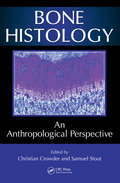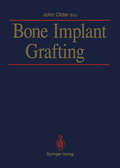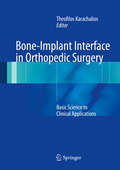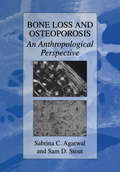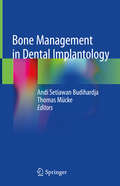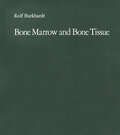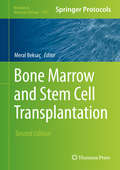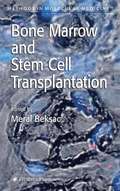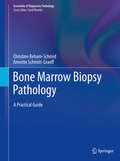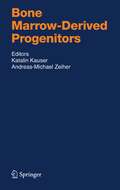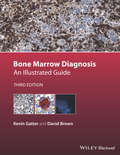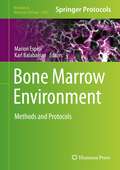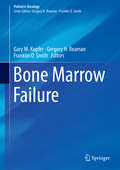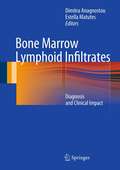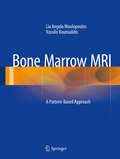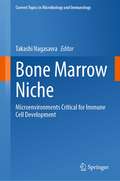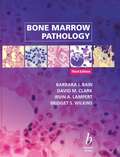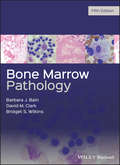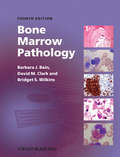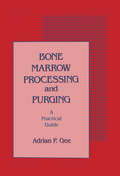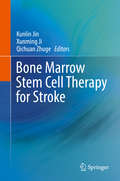- Table View
- List View
Bone Histology: An Anthropological Perspective
by Christian Crowder Sam StoutA broad understanding of bone and tooth microstructure is necessary for constructing the biological profile of an individual or individuals within a population. Bone Histology: An Anthropological Perspective brings together authors with extensive experience and expertise in various aspects of hard tissue histology to provide a comprehensive discuss
Bone Implant Grafting
by M. W. J.OlderSurgeons differ in their enthusiasm for autografts, allografts and metallic implants, nevertheless, all have their place in orthopedic surgery. For some defects in the skeleton, bone grafting may be the only solution. The pros and cons of bone grafting are thoroughly discussed by eighteen distinguished authorities in this book. Their exchange of views and experiences reflects the diversity of thinking worldwide and points to exciting possibilities for future improvements. The twenty-eight chapters describe: the natural history and immunology of auto and allografting; innovative surgical techniques together with results, whether successful or not; and bone banking and its related problems, especially HIV.
Bone-Implant Interface in Orthopedic Surgery: Basic Science to Clinical Applications
by Theofilos KarachaliosTotal joint arthroplasty is an effective surgical procedure for end-stage osteoarthritis of major joints with satisfactory long term clinical outcome. A large and growing number of arthroplasties are performed annually worldwide and a great number of orthopaedic surgeons are practicing arthroplasty surgery as their main surgical activity. The biological behavior of the bone-implant interface is crucial for the long term survival of the artificial joint. All factors which have a positive or negative effect on the interface are of great interest for those practicing arthroplasty surgery. Basic scientists and the industry are continuously searching for new implant fixation mechanisms and improved materials. There is an accumulation of a great amount of basic science data (both biological, material and mechanical) related to the incorporation or loosening of the bone-implant interface. However, basic science data does not always translate to satisfactory clinical application, and orthopaedic practitioners often wonder which piece of information is clinically useful. A further problem is that basic scientists often speak their own scientific language and may not fully appreciate common clinical practice needs. In this textbook the biological and mechanical mechanisms of implant incorporation and loosening will be presented. All new data concerning materials and methods for incorporation enhancement will be critically analyzed. Data useful for clinical application will be stressed. Orthopaedic Surgeons will find information which will improve their clinical practice and basic scientists will be helped to understand and appreciate clinical needs.
Bone Loss and Osteoporosis: An Anthropological Perspective
by Sabrina C. Agarwal and Sam D. StoutWith the growing incidence of fragility fractures in Europe and North America over the last three decades, bone loss and osteoporosis have become active areas of research in skeletal biology. Bone loss is associated with aging in both sexes and is accelerated in women with the onset of menopause. However, bone loss is related to a suite of complex and often synergistically related factors including genetics, pathology, nutrition, mechani cal usage, and lifestyle. It is not surprising that its incidence and severity vary among populations. There has been increasing interest to investigate bone loss and osteoporosis from an anthropological perspective that utilizes a biocultural approach. Biocultural approaches recognize the inter-relationship between biological, cultural, and environmental variables. Anthropological studies also highlight the value of evolutionary and population approaches to the study of bone loss. These approaches are particularly suited to elucidate the multifactorial etiology of bone loss. The idea for this volume came out of a symposium organized by the editors at the 70th annual meeting of The American Association of Physical Anthropologists in Kansas City, Missouri. Many of the symposium participants, along with several additional leading scientists involved in bone and osteoporosis research, are brought together in this volume. Each chapter focuses on a different aspect of bone loss and fragility with a fresh and stimulating perspective.
Bone Management in Dental Implantology
by Andi Setiawan Budihardja Thomas MückeThis book describes all methods of bone management currently employed within the field of dental implantology, with the aim of equipping oral surgeons and other practitioners with a sound practical understanding of bone augmentation. The different possibilities for augmentation of the jaw in the vertical and horizontal dimensions are explained, and detailed information provided on the latest techniques of augmentation, including guided bone regeneration, mandibular bone grafting, 3D technique, extraoral bone augmentation, and microvascular bone transplantation. Readers will find clear guidance on diagnosis and treatment planning and helpful discussion of the basic principles of bone augmentation. Individual chapters also address the role of lasers, complications and risks, and emerging trends. The extensive case documentation, with numerous color illustrations and photos, highlights what is possible today in the field of bone regeneration. This book is a “must read” for all implantologists, oral maxillofacial surgeons, periodontists, and dentists with an interest in oral surgery.
Bone Marrow and Stem Cell Transplantation (Methods in Molecular Biology #1109)
by Meral BeksaçThe second edition of Bone Marrow and Stem Cell Transplantation expands upon the previous edition with current, detailed methods on HLA, minor-HLA and Killer Immunoglobulin Like Receptor typing. With new chapters on immunophenotyping and functional characterization of stem cells are included. Written in the highly successful Methods in Molecular Biology series format, chapters include introductions to their respective topics, lists of the necessary materials and reagents, step-by-step, readily reproducible laboratory protocols, and tips on troubleshooting and avoiding known pitfalls. Authoritative and practical, Bone Marrow and Stem Cell Transplantation, Second Edition serves as a guide in the application of molecular methods for routine or investigational purposes.
Bone Marrow and Stem Cell Transplantation (Methods in Molecular Medicine #134)
by Meral BeksacThis volume is a compendium of cutting-edge molecular methods for the successful transplantation of hematopoietic stem cells. The contributors are world-renown leaders in the field. They describe promising tools for stem cell transplant research models, such as in vivo bioluminescence imaging. They discuss HLA typing, PCR-SSP typing, and HLA antigens. This volume is an invaluable source for biochemists, molecular biologists, and clinicians.
Bone Marrow Biopsy Pathology: A Practical Guide (Essentials of Diagnostic Pathology)
by Christine Beham-Schmid Annette Schmitt-GraeffThis comprehensive, superbly illustrated reference is designed to provide practical diagnostic assistance for hematopathologists when dealing with common and uncommon lesions in bone marrow trephine biopsies (BMTBs). At the heart of the book is a systematic analysis of neoplastic hematological and non-hematological disease entities, with concise identification of the key features of myeloproliferative neoplasms, myelodysplastic syndromes, acute and chronic leukemias, eosinophilia-associated myeloid/lymphoid neoplasms, lymphoproliferative disorders, and selected non-hematopoietic malignancies. Relevant examples of BMTBs are presented, with microscopic description, high-quality photomicrographs, and clinical data. The book also explains how to assess hematopoietic and stromal components of normal BMTBs, identifies the heterogeneous patterns that may be observed in healthy individuals, and analyzes reactive conditions, with particular attention to diagnostic problems and pitfalls.
Bone Marrow-Derived Progenitors (Handbook of Experimental Pharmacology #180)
by Katalin Kauser Andreas Michael ZeiherThe ambitious goal of this volume is to provide – in chapters written by accomplished scientists and experts in their field – a comprehensive overview of the currently available information related to the therapeutic utility of adult bone marrow-derived cells. With excitement generated almost daily about the possible uses of stem cells to treat human disease, but the controversy surrounding their use still raging, adult bone-marrow derived cells are more readily available, and have a staggering range of uses.
Bone Marrow Diagnosis: An Illustrated Guide
by Kevin Gatter David BrownBone Marrow Diagnosis, Third Edition, is an essential resource for pathologists and haematologists who need to report bone marrow trephine biopsies. Practical and highly illustrated this edition has been comprehensively updated whilst remaining succinct and concentrating on the core information necessary to make an accurate diagnosis. The text provides comparisons of the common methods of sample collection, fixation and staining, and a clear description of how to examine a trephine section. Applying a consistent approach, the chapters cover the range of disorders of bone marrow, discussing the clinical features, histopathology of bone marrow and diagnostic problems of each condition. Each chapter closes with a summary of key points and each diagnostic entity is accompanied by high quality images, over 900 in all, showing typical and more unusual examples of histological features. This compact text, oriented at diagnosis and comprehensively accompanied by usable illustrations, is an invaluable reference tool for the trainee and practicing histopathologists, pathologists and haematologists. A practical guide aimed at allowing a busy pathologist to easily find the essential description and illustration of the most common bone marrow diseases seen in trephines Covers new treatment for chronic myeloid leukaemia, B-cell lymphoma and antibody treatments High quality colour images accompany each diagnostic entity Coverage of cytology in sections relating to myeloid dysplasias and acute leukaemias Addresses lymphoma categorization and individual lymphoma entities Incorporates new WHO classifications of lymphomas and leukaemias
Bone Marrow Diagnosis: An Illustrated Guide
by Kevin Gatter David BrownBone Marrow Diagnosis, Third Edition, is an essential resource for pathologists and haematologists who need to report bone marrow trephine biopsies. Practical and highly illustrated this edition has been comprehensively updated whilst remaining succinct and concentrating on the core information necessary to make an accurate diagnosis. The text provides comparisons of the common methods of sample collection, fixation and staining, and a clear description of how to examine a trephine section. Applying a consistent approach, the chapters cover the range of disorders of bone marrow, discussing the clinical features, histopathology of bone marrow and diagnostic problems of each condition. Each chapter closes with a summary of key points and each diagnostic entity is accompanied by high quality images, over 900 in all, showing typical and more unusual examples of histological features. This compact text, oriented at diagnosis and comprehensively accompanied by usable illustrations, is an invaluable reference tool for the trainee and practicing histopathologists, pathologists and haematologists. A practical guide aimed at allowing a busy pathologist to easily find the essential description and illustration of the most common bone marrow diseases seen in trephines Covers new treatment for chronic myeloid leukaemia, B-cell lymphoma and antibody treatments High quality colour images accompany each diagnostic entity Coverage of cytology in sections relating to myeloid dysplasias and acute leukaemias Addresses lymphoma categorization and individual lymphoma entities Incorporates new WHO classifications of lymphomas and leukaemias
Bone Marrow Environment: Methods and Protocols (Methods in Molecular Biology #2308)
by Marion Espéli Karl BalabanianThis volume brings together classical and cutting-edge protocols on the spatio-temporal study of the cellular subsets constituting the bone and the marrow in both mouse and human. Chapters details methods on bone marrow (BM) ecosystem, to label, sort, analyse, and culture specific cell subsets as well as techniques allowing the evaluation of the function of some of the cellular elements of the BM. Written in the highly successful Methods in Molecular Biology series format, chapters include introductions to their respective topics, lists of the necessary materials and reagents, step-by-step, readily reproducible laboratory protocols, and tips on troubleshooting and avoiding known pitfalls. Authoritative and cutting-edge, Bone Marrow Environment: Methods and Protocols aims to help new investigators to pursue the characterization of the BM microenvironment in the coming years.
Bone Marrow Failure (Pediatric Oncology)
by Gary M. Kupfer Gregory H. Reaman Franklin O. SmithThis book presents the latest scientific knowledge on inherited and acquired bone marrow failure syndromes, describing the advances in understanding of genetics and pathophysiology that have been achieved as a result of high-throughput DNA sequencing, RNA expression studies, and modern biochemistry techniques. The full range of relevant conditions is covered, including acquired aplastic anemia, Fanconi anemia, ribosomopathies, telomeropathies, dyskeratosis congenita, Shwachman-Diamond syndrome, Diamond-Blackfan anemia, and congenital neutropenias and thrombocytopenias. In addition, it is explained how the study of these rare diseases has uncovered important new science and elucidated the pathophysiology of more common hematological and oncological diseases. A treatment-specific chapter describes options ranging from the conventional to the cutting edge. Bone Marrow Failure will be of value for both trainee and practicing hematologists and oncologists.
Bone Marrow Lymphoid Infiltrates: Diagnosis and Clinical Impact
by Dimitra Anagnostou and Estella MatutesThis monograph aims to cover in depth all aspects of bone marrow lymphoid infiltrates, in the context of their wide spectrum of benign, borderline and malignant expressions. As the bone marrow is no longer considered a selective diagnostic procedure in the field of haematopathology and haematology,but a routine need to other subspecialists, we intend to provide a comprehensive treatise for beginners and experienced practitioners alike who deal with patients that are investigated or treated for lymphomas and lymphoid leukemias, manifest with laboratory or clinical signs suspicious for haematological diseases or show features mimicking haematological conditions.
Bone Marrow MRI: A Pattern-Based Approach
by Lia Angela Moulopoulos Vassilis KoutoulidisMRI provides the best means of imaging the bone marrow directly and of non-invasively assessing its composition. Normal age-related bone marrow changes, alterations related to red marrow reconversion, and pathological bone marrow processes generally conform to certain patterns that reflect the underlying marrow changes and can be clearly recognized on MR images. In addition to conventional pulse sequences, advanced MRI techniques such as Dynamic Contrast-Enhanced MRI and Diffusion-Weighted Imaging depict marrow changes at the microvascular and cellular level respectively. This book provides radiologists with in-depth information on the MRI appearances of normal, abnormal and treated marrow following a structured, pattern-based approach. MRI findings for various diseases that affect the bone marrow, particularly those of a malignant nature, are presented in detail. MRI pattern recognition not only offers a systematic approach to image interpretation and diagnosis but also has prognostic implications with regard to some disease entities. Each chapter includes a wealth of high-quality images, together with Key Points summarizing the most important information. In addition to radiologists, practitioners with an interest in hematology and oncology will find this textbook-atlas to be a valuable resource for the latest, clinically relevant advances in bone marrow imaging.
Bone Marrow Niche: Microenvironments Critical for Immune Cell Development (Current Topics in Microbiology and Immunology #434)
by Takashi NagasawaThis volume summarizes recent advances in research on mesenchymal cell populations in the bone marrow. It explores how mesenchymal cells create niches for immune cells in extramedullary organs and it discusses new concepts of lympho-hematopoietic microenvironments. Readers are introduced to the fundamentals of hematopoietic stem cells (HSCs) differentiation to all types of blood cells, including immune cells, in the bone marrow. The book highlights how this process is supported and regulated by the individual microenvironments of stem cells, termed niches.The identity of HSC niches has been subject to longstanding debates. Recent studies identified the population of mesenchymal stem cells as the major cellular component of niches, for hematopoietic stem and progenitor cells (HSPCs) and their candidate developmental origin. Furthermore, candidate cellular niches for immune cells in lymph nodes and adipose and connective tissues were identified. The authors of this volume focus on shared features between those and HSPC niche cells in the bone marrow. Covering latest research results, this book serves as fascinating read for researchers and clinicians in hematology and immunology.
Bone Marrow Pathology
by Barbara J. Bain David M. Clark Irvin A. Lampert Bridget S. WilkinsWritten by one of the world's leading haematologists, and three renowned histopathologists, Bone Marrow Pathology provides a comprehensive guide to the diagnosis of bone marrow disease. Now in its Third Edition, the text has been extensively revised and rewritten to reflect the latest advances in the field. Features: An extremely practical, up-to-the-minute text incorporating the new WHO classification of haematopoietic malignancies A comprehensive text written with great precision and clarity of style Incorporates a new section 'Problems and Pitfalls' - a unique section that will aid the working pathologist faced with a difficult situation An important text for the haematologist, histopathologist and haematopathologist with equal weight given to peripheral blood, aspirate, trephine biology and specialized techniques Extensively illustrated with many of the photographs being of paraffin-embedded sections Combines all the techniques now applied to bone marrow diagnosis, including immunocytochemistry, flow cytometery, immunohistochemistry and the diagnostic role of cytogenetic and molecular genetic analysis
Bone Marrow Pathology
by Barbara J. Bain David M. Clark Bridget S. WilkinsBone Marrow Pathology has been extensively revised to reflect the significant advances which have occurred in the application of cytogenetics and in particular, molecular genetics in the diagnosis, classification and understanding of haematological disorders. This comprehensive book not only provides information on all common disease entities, but also covers rare disorders in which bone marrow examination is useful. It is designed as a practical resource with "problems and pitfalls" highlighted throughout to aid laboratory diagnosis.
Bone Marrow Pathology
by Barbara J. Bain David M. Clark Bridget S. WilkinsBone Marrow Pathology has been extensively revised to reflect the significant advances which have occurred in the application of cytogenetics and in particular, molecular genetics in the diagnosis, classification and understanding of haematological disorders. This comprehensive book not only provides information on all common disease entities, but also covers rare disorders in which bone marrow examination is useful. It is designed as a practical resource with "problems and pitfalls" highlighted throughout to aid laboratory diagnosis.
Bone Marrow Pathology
by Barbara J. Bain David M. Clark Bridget S. WilkinsBone Marrow Pathology has been extensively revised to reflect the significant advances which have occurred in the application of cytogenetics and in particular, molecular genetics in the diagnosis, classification and understanding of haematological disorders. This comprehensive book not only provides information on all common disease entities, but also covers rare disorders in which bone marrow examination is useful. It is designed as practical resource with ‘Problems and Pitfalls’ sections throughout to aid laboratory diagnosis. This fourth edition: Incorporates the recommendations of the 2008 WHO Classification of Tumours of Haematopoietic and Lymphoid Tissues Covers key diagnostic techniques such as flow cytometric immunophenotyping, immunohistochemistry and cytogenetic and molecular genetic analysis Includes new diagnostic algorithms and summary boxes Contains 550 colour illustrations including high-quality digital photomicrographs Haematologists and histopathologists will find this book an invaluable desktop reference when performing daily blood and bone marrow investigations.
Bone Marrow Pathology
by Barbara J. Bain David M. Clark Bridget S. WilkinsBone Marrow Pathology has been extensively revised to reflect the significant advances which have occurred in the application of cytogenetics and in particular, molecular genetics in the diagnosis, classification and understanding of haematological disorders. This comprehensive book not only provides information on all common disease entities, but also covers rare disorders in which bone marrow examination is useful. It is designed as practical resource with ‘Problems and Pitfalls’ sections throughout to aid laboratory diagnosis. This fourth edition: Incorporates the recommendations of the 2008 WHO Classification of Tumours of Haematopoietic and Lymphoid Tissues Covers key diagnostic techniques such as flow cytometric immunophenotyping, immunohistochemistry and cytogenetic and molecular genetic analysis Includes new diagnostic algorithms and summary boxes Contains 550 colour illustrations including high-quality digital photomicrographs Haematologists and histopathologists will find this book an invaluable desktop reference when performing daily blood and bone marrow investigations.
Bone Marrow Processing and Purging: a Practical Guide
by Adrian P. GeeBone Marrow Processing and Purging: A Practical Guide provides an up-to-date practical guide to the major ex vivo procedures associated with bone marrow transplantation. Previously, this information was communicated primarily by word of mouth; now experts in the field present detailed descriptions and evaluations of methods for marrow harvesting, evaluation (including tumor infiltration, flow cytometric analysis, and colony assays), comparative methods for automated nucleated cell separation and enumeration, tumor cell purging, T cell depletion, stem cell selection, gene transfer, and cytopreservation. Special sections address quality control and FDA regulations. The book provides a unique information source intended for clinicians, researchers, technical staff, transplant nurses, and medical students involved in this rapidly expanding area of medicine.
Bone Marrow Processing and Purging: a Practical Guide
by Adrian P. GeeBone Marrow Processing and Purging: A Practical Guide provides an up-to-date practical guide to the major ex vivo procedures associated with bone marrow transplantation. Previously, this information was communicated primarily by word of mouth; now experts in the field present detailed descriptions and evaluations of methods for marrow harvesting, evaluation (including tumor infiltration, flow cytometric analysis, and colony assays), comparative methods for automated nucleated cell separation and enumeration, tumor cell purging, T cell depletion, stem cell selection, gene transfer, and cytopreservation. Special sections address quality control and FDA regulations. The book provides a unique information source intended for clinicians, researchers, technical staff, transplant nurses, and medical students involved in this rapidly expanding area of medicine.
Bone marrow stem cell therapy for stroke
by Kunlin Jin Xunming Ji Qichuan ZhugeThis book covers recent advances in all aspects of bone marrow-derived stem cells (BMSCs) for stroke treatment, while also providing comprehensive information on human clinical trials and animal models of stroke. In addition, it reviews the optimal conditions of transplantation for stroke therapy and potential mechanisms underlying transplanted cell-mediated functional recovery after stroke. As the first book to focus on BMSC therapy for stroke, it also discusses in depth the unique challenges of BMSCs-based therapy in this context.
